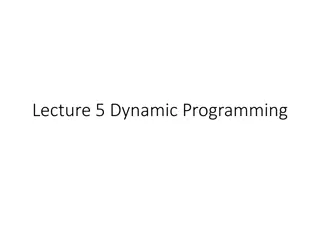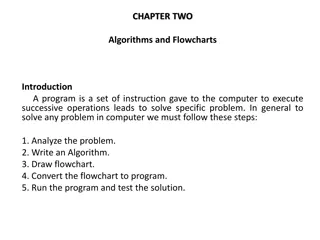Longest Increasing Subsequence Problem and Solution
The Longest Increasing Subsequence problem involves finding a subsequence in a given sequence that is strictly increasing and of maximum length. The solution utilizes Dynamic Programming by maintaining arrays to store indices and track the longest increasing subsequence. By iterating over the list, the algorithm efficiently determines the subsequence. The example demonstrates the process step by step.
Download Presentation

Please find below an Image/Link to download the presentation.
The content on the website is provided AS IS for your information and personal use only. It may not be sold, licensed, or shared on other websites without obtaining consent from the author.If you encounter any issues during the download, it is possible that the publisher has removed the file from their server.
You are allowed to download the files provided on this website for personal or commercial use, subject to the condition that they are used lawfully. All files are the property of their respective owners.
The content on the website is provided AS IS for your information and personal use only. It may not be sold, licensed, or shared on other websites without obtaining consent from the author.
E N D
Presentation Transcript
Longest Increasing Subsequence By Adri Wessels IOI Training Camp 3 (9-10 March 2019)
The Problem: Given a sequence (e.g. 10, 2, 6, 13, 4, 5) find a subsequence (e.g. 2, 13, 4) such that the subsequence is the longest (strictly) increasing subsequence.
The Solution: The solution uses DP. Let seq be the array containing the sequences. We let mem be an array where mem[j] stores the index k of the smallest seq[k] such that there is an increasing subsequence of length j ending with seq[k]. We let prev[j] store the second last number in the longest increasing subsequence ending at seq[j]. Now we build up mem by noticing that if seq[i] is less than seq[mem[j]] and seq[i] is greater than seq[mem[j-1]] then mem[j] should be i because then you end the subsequence with a lower number.
The Solution: Also prev[i] is then set to mem[j-1] because at this point in time the sequence ending with seq[mem[j-1]] is the smallest sequence that is j-1 long and thus the optimal choice to go before I in a subsequence. We then iterate over the entire list and fill in mem and prev while keeping track of the length of our longest increasing subsequence. At the end we start at mem[length] and work backwards along the subsequence by using prev to eventually get the full sequence.
The Example: We will use the commonly used example from Wikipedia which is the sequence: 0, 8, 4, 12, 2, 10, 6, 14, 1, 9, 5, 13, 3, 11, 7, 15 Reminder: mem[j] = k s.t. s[k] is the smallest last number in an increasing subsequence of length j. prev[j] = the second last number in the longest increasing subsequence ending at seq[j].
The Example: Indices: Seq: Current index i = -1 Mem: 0 Prev: 0 0 1 8 2 4 3 12 4 2 5 10 6 6 7 14 8 1 9 9 10 5 11 13 12 3 13 11 14 7 15 15 Reminder: mem[j] = k s.t. s[k] is the smallest last number in an increasing subsequence of length j. prev[j] = the second last number in the longest increasing subsequence ending at seq[j].
The Example: Indices: Seq: Current index i = 0 Mem: 0, 0 Prev: 0 0 0 1 8 2 4 3 12 4 2 5 10 6 6 7 14 8 1 9 9 10 5 11 13 12 3 13 11 14 7 15 15 Reminder: mem[j] = k s.t. s[k] is the smallest last number in an increasing subsequence of length j. prev[j] = the second last number in the longest increasing subsequence ending at seq[j].
The Example: Indices: Seq: Current index i = 1; Mem: 0, 0, 1 Prev: 0, 0 0 0 1 8 2 4 3 12 4 2 5 10 6 6 7 14 8 1 9 9 10 5 11 13 12 3 13 11 14 7 15 15 Reminder: mem[j] = k s.t. s[k] is the smallest last number in an increasing subsequence of length j. prev[j] = the second last number in the longest increasing subsequence ending at seq[j].
The Example: Indices: Seq: Current index i = 2; Mem: 0, 0, 2 Prev: 0, 0, 0 0 0 1 8 2 4 3 12 4 2 5 10 6 6 7 14 8 1 9 9 10 5 11 13 12 3 13 11 14 7 15 15 Reminder: mem[j] = k s.t. s[k] is the smallest last number in an increasing subsequence of length j. prev[j] = the second last number in the longest increasing subsequence ending at seq[j].
The Example: Indices: Seq: Current index i = 3; Mem: 0, 0, 2, 3 Prev: 0, 0, 0, 2 0 0 1 8 2 4 3 12 4 2 5 10 6 6 7 14 8 1 9 9 10 5 11 13 12 3 13 11 14 7 15 15 Reminder: mem[j] = k s.t. s[k] is the smallest last number in an increasing subsequence of length j. prev[j] = the second last number in the longest increasing subsequence ending at seq[j].
The Example: Indices: Seq: Current index i = 4; Mem: 0, 0, 4, 3 Prev: 0, 0, 0, 2, 0 0 0 1 8 2 4 3 12 4 2 5 10 6 6 7 14 8 1 9 9 10 5 11 13 12 3 13 11 14 7 15 15 Reminder: mem[j] = k s.t. s[k] is the smallest last number in an increasing subsequence of length j. prev[j] = the second last number in the longest increasing subsequence ending at seq[j].
The Example: Indices: Seq: Current index i = 5; Mem: 0, 0, 4, 5 Prev: 0, 0, 0, 2, 0, 4 0 0 1 8 2 4 3 12 4 2 5 10 6 6 7 14 8 1 9 9 10 5 11 13 12 3 13 11 14 7 15 15 Reminder: mem[j] = k s.t. s[k] is the smallest last number in an increasing subsequence of length j. prev[j] = the second last number in the longest increasing subsequence ending at seq[j].
The Example: Indices: Seq: Current index i = 6; Mem: 0, 0, 4, 6 Prev: 0, 0, 0, 2, 0, 4, 4 0 0 1 8 2 4 3 12 4 2 5 10 6 6 7 14 8 1 9 9 10 5 11 13 12 3 13 11 14 7 15 15 Reminder: mem[j] = k s.t. s[k] is the smallest last number in an increasing subsequence of length j. prev[j] = the second last number in the longest increasing subsequence ending at seq[j].
The Example: Indices: Seq: Current index i = 7; Mem: 0, 0, 4, 6, 7 Prev: 0, 0, 0, 2, 0, 4, 4, 6 0 0 1 8 2 4 3 12 4 2 5 10 6 6 7 14 8 1 9 9 10 5 11 13 12 3 13 11 14 7 15 15 Reminder: mem[j] = k s.t. s[k] is the smallest last number in an increasing subsequence of length j. prev[j] = the second last number in the longest increasing subsequence ending at seq[j].
The Example: Indices: Seq: Current index i = 8; Mem: 0, 0, 8, 6, 7 Prev: 0, 0, 0, 2, 0, 4, 4, 6, 0 0 0 1 8 2 4 3 12 4 2 5 10 6 6 7 14 8 1 9 9 10 5 11 13 12 3 13 11 14 7 15 15 Reminder: mem[j] = k s.t. s[k] is the smallest last number in an increasing subsequence of length j. prev[j] = the second last number in the longest increasing subsequence ending at seq[j].
The Example: Indices: Seq: Current index i = 9; Mem: 0, 0, 8, 6, 9 Prev: 0, 0, 0, 2, 0, 4, 4, 6, 0, 6 0 0 1 8 2 4 3 12 4 2 5 10 6 6 7 14 8 1 9 9 10 5 11 13 12 3 13 11 14 7 15 15 Reminder: mem[j] = k s.t. s[k] is the smallest last number in an increasing subsequence of length j. prev[j] = the second last number in the longest increasing subsequence ending at seq[j].
The Example: Indices: Seq: Current index i = 10; Mem: 0, 0, 8, 10, 9 Prev: 0, 0, 0, 2, 0, 4, 4, 6, 0, 6, 8 0 0 1 8 2 4 3 12 4 2 5 10 6 6 7 14 8 1 9 9 10 5 11 13 12 3 13 11 14 7 15 15 Reminder: mem[j] = k s.t. s[k] is the smallest last number in an increasing subsequence of length j. prev[j] = the second last number in the longest increasing subsequence ending at seq[j].
The Example: Indices: Seq: Current index i = 11; Mem: 0, 0, 8, 10, 9, 11 Prev: 0, 0, 0, 2, 0, 4, 4, 6, 0, 6, 8, 9 0 0 1 8 2 4 3 12 4 2 5 10 6 6 7 14 8 1 9 9 10 5 11 13 12 3 13 11 14 7 15 15 Reminder: mem[j] = k s.t. s[k] is the smallest last number in an increasing subsequence of length j. prev[j] = the second last number in the longest increasing subsequence ending at seq[j].
The Example: Indices: Seq: Current index i = 12; Mem: 0, 0, 8, 12, 9, 11 Prev: 0, 0, 0, 2, 0, 4, 4, 6, 0, 6, 8, 9, 8 0 0 1 8 2 4 3 12 4 2 5 10 6 6 7 14 8 1 9 9 10 5 11 13 12 3 13 11 14 7 15 15 Reminder: mem[j] = k s.t. s[k] is the smallest last number in an increasing subsequence of length j. prev[j] = the second last number in the longest increasing subsequence ending at seq[j].
The Example: Indices: Seq: Current index i = 13; Mem: 0, 0, 8, 12, 9, 13 Prev: 0, 0, 0, 2, 0, 4, 4, 6, 0, 6, 8, 9, 8, 9 0 0 1 8 2 4 3 12 4 2 5 10 6 6 7 14 8 1 9 9 10 5 11 13 12 3 13 11 14 7 15 15 Reminder: mem[j] = k s.t. s[k] is the smallest last number in an increasing subsequence of length j. prev[j] = the second last number in the longest increasing subsequence ending at seq[j].
The Example: Indices: Seq: Current index i = 14; Mem: 0, 0, 8, 12, 14, 13 Prev: 0, 0, 0, 2, 0, 4, 4, 6, 0, 6, 8, 9, 8, 9, 12 0 0 1 8 2 4 3 12 4 2 5 10 6 6 7 14 8 1 9 9 10 5 11 13 12 3 13 11 14 7 15 15 Reminder: mem[j] = k s.t. s[k] is the smallest last number in an increasing subsequence of length j. prev[j] = the second last number in the longest increasing subsequence ending at seq[j].
The Example: Indices: Seq: Current index i = 15; Mem: 0, 0, 8, 12, 14, 13, 15 Prev: 0, 0, 0, 2, 0, 4, 4, 6, 0, 6, 8, 9, 8, 9, 12, 13 0 0 1 8 2 4 3 12 4 2 5 10 6 6 7 14 8 1 9 9 10 5 11 13 12 3 13 11 14 7 15 15 Reminder: mem[j] = k s.t. s[k] is the smallest last number in an increasing subsequence of length j. prev[j] = the second last number in the longest increasing subsequence ending at seq[j].
The Example: Indices: Seq: Current index i = 15; Mem: 0, 0, 8, 12, 14, 13, 15 Prev: 0, 0, 0, 2, 0, 4, 4, 6, 0, 6, 8, 9, 8, 9, 12, 13 Longest Increasing Subsequence: In reverse: 15 0 0 1 8 2 4 3 12 4 2 5 10 6 6 7 14 8 1 9 9 10 5 11 13 12 3 13 11 14 7 15 15 Reminder: mem[j] = k s.t. s[k] is the smallest last number in an increasing subsequence of length j. prev[j] = the second last number in the longest increasing subsequence ending at seq[j].
The Example: Indices: Seq: Current index i = 15; Mem: 0, 0, 8, 12, 14, 13, 15 Prev: 0, 0, 0, 2, 0, 4, 4, 6, 0, 6, 8, 9, 8, 9, 12, 13 Longest Increasing Subsequence: In reverse: 15, 11 0 0 1 8 2 4 3 12 4 2 5 10 6 6 7 14 8 1 9 9 10 5 11 13 12 3 13 11 14 7 15 15 Reminder: mem[j] = k s.t. s[k] is the smallest last number in an increasing subsequence of length j. prev[j] = the second last number in the longest increasing subsequence ending at seq[j].
The Example: Indices: Seq: Current index i = 15; Mem: 0, 0, 8, 12, 14, 13, 15 Prev: 0, 0, 0, 2, 0, 4, 4, 6, 0, 6, 8, 9, 8, 9, 12, 13 Longest Increasing Subsequence: In reverse: 15, 11, 9 0 0 1 8 2 4 3 12 4 2 5 10 6 6 7 14 8 1 9 9 10 5 11 13 12 3 13 11 14 7 15 15 Reminder: mem[j] = k s.t. s[k] is the smallest last number in an increasing subsequence of length j. prev[j] = the second last number in the longest increasing subsequence ending at seq[j].
The Example: Indices: Seq: Current index i = 15; Mem: 0, 0, 8, 12, 14, 13, 15 Prev: 0, 0, 0, 2, 0, 4, 4, 6, 0, 6, 8, 9, 8, 9, 12, 13 Longest Increasing Subsequence: In reverse: 15, 11, 9, 6 0 0 1 8 2 4 3 12 4 2 5 10 6 6 7 14 8 1 9 9 10 5 11 13 12 3 13 11 14 7 15 15 Reminder: mem[j] = k s.t. s[k] is the smallest last number in an increasing subsequence of length j. prev[j] = the second last number in the longest increasing subsequence ending at seq[j].
The Example: Indices: Seq: Current index i = 15; Mem: 0, 0, 8, 12, 14, 13, 15 Prev: 0, 0, 0, 2, 0, 4, 4, 6, 0, 6, 8, 9, 8, 9, 12, 13 Longest Increasing Subsequence: In reverse: 15, 11, 9, 6, 2 0 0 1 8 2 4 3 12 4 2 5 10 6 6 7 14 8 1 9 9 10 5 11 13 12 3 13 11 14 7 15 15 Reminder: mem[j] = k s.t. s[k] is the smallest last number in an increasing subsequence of length j. prev[j] = the second last number in the longest increasing subsequence ending at seq[j].
The Example: Indices: Seq: Current index i = 15; Mem: 0, 0, 8, 12, 14, 13, 15 Prev: 0, 0, 0, 2, 0, 4, 4, 6, 0, 6, 8, 9, 8, 9, 12, 13 Longest Increasing Subsequence: In reverse: 15, 11, 9, 6, 2, 0 0 0 1 8 2 4 3 12 4 2 5 10 6 6 7 14 8 1 9 9 10 5 11 13 12 3 13 11 14 7 15 15 Reminder: mem[j] = k s.t. s[k] is the smallest last number in an increasing subsequence of length j. prev[j] = the second last number in the longest increasing subsequence ending at seq[j].
The Example: Indices: Seq: Current index i = 15; Mem: 0, 0, 8, 12, 14, 13, 15 Prev: 0, 0, 0, 2, 0, 4, 4, 6, 0, 6, 8, 9, 8, 9, 12, 13 Longest Increasing Subsequence: In reverse: 15, 11, 9, 6, 2, 0 Finally: 0, 2, 6, 9, 11, 15 0 0 1 8 2 4 3 12 4 2 5 10 6 6 7 14 8 1 9 9 10 5 11 13 12 3 13 11 14 7 15 15 Reminder: mem[j] = k s.t. s[k] is the smallest last number in an increasing subsequence of length j. prev[j] = the second last number in the longest increasing subsequence ending at seq[j].
The Code: The Setup:
The Code: The Loop:
The Code: The Result:























